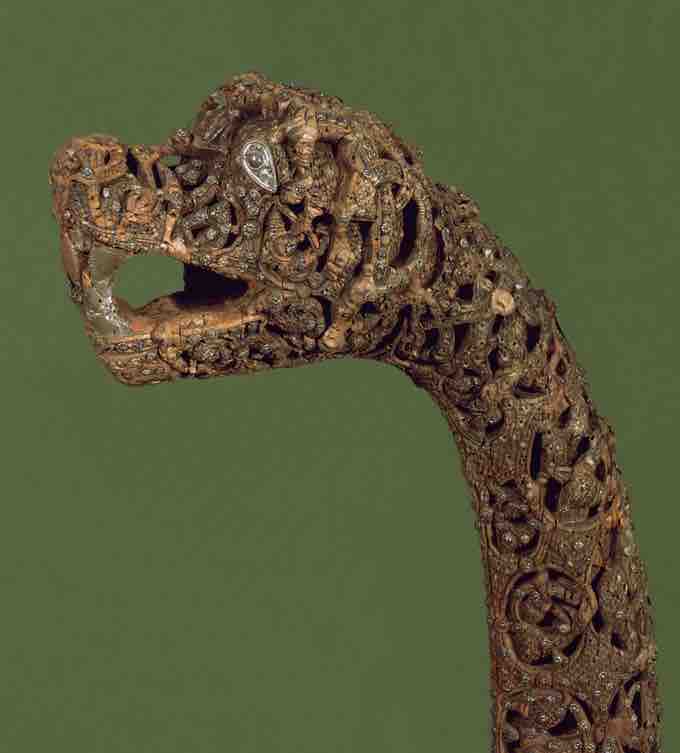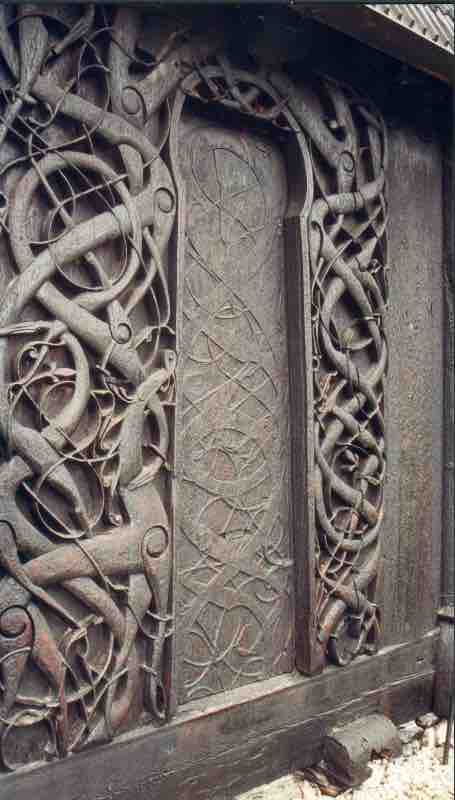"Norse art" is a blanket term for the artistic styles in Scandinavia during the Germanic Iron Age, the Viking Age, and the Nordic Bronze Age. Norse art has many elements in common with Celtic Art and Romanesque art.
Of Scandinavian descent, Norsemen are often called Vikings after their trading places from the Norwegian shoreline. Known as pre-Christian traders and pirates, Vikings used their great ships to invade European coasts, harbors, and river settlements on a seasonal basis. They created fast and seaworthy longships that served not only as warring and trading vessels, but also as media for artistic expression and individual design.
The great ships of the Vikings contain some of the major art pieces left from this time. For instance, the Oseberg Bow demonstrates the Norse mastery of decorative wood carving . Likewise, the ship head post—representing a roaring beast—is five inches high with complicated surface ornamentation in the form of interwoven animals that twist and turn .

Oseberg Ship Head Post
Animal-head post found in the Oseberg viking ship, seen in the Viking Ship Museum, Oslo, Norway. The exact function of the head post is unknown.

Oseberg Bow
Carved detail from the back bow of the Oseberg ship. The Oseberg Bow demonstrates the Norse mastery of decorative wood carving.
Other examples of artistic design on Norse ships include the "King" or "Chieftain" vessels that were designated for the wealthier classes. Chieftain ships were distinguishable by the design of the bow of their vessel. This could involve various types of design such as bulls, dolphins, gold lions, drakes spewing fire out of their nose, human beings cast in gold and silver, and other unidentifiable animals cast in bronze metal. Typically, the sides of these vessels were decorated using bright colors and wood-carvings.
The majority of Viking and Barbarian art consisted of small, portable objects. Whereas the Norse ships highlight the most distinctive elements of Norse art, brooches and other Viking ornaments demonstrate considerable Celtic influence (evident in the characteristically large oval shapes of both Norse and Celtic brooches). Typically, Viking brooches and buckles were connected together by bands of metal with the spaces between them forming an animal motif. Such decoration can be attributed to earlier representations of lions or other creatures from Roman and Celtic art.
During the eleventh century, many Norsemen converted to Christianity and subsequently brought their artistic traditions to religious themes. For instance, the decoration of the wooden portal of the stave church located in Urnes, Norway is composed of abstract animal forms that tightly intertwine with flexible plant stalks in a spiral pattern . This is one of the few remains left from this time that were later incorporated in the walls of a twelfth century church. While pagan-inspired motifs were spreading in Christian Norse art, northern European Christian missionaries were creating a visual Christian content that was very different from early barbarian legacies.

Urnes Stave Church
This carving demonstrates the fusion of Norse-inspired artistic tradition with Western Christian subjects.